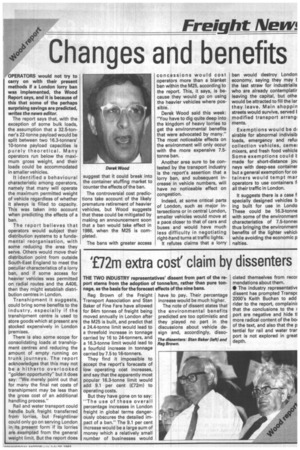'£72m extra cost' claim by dissenters
Page 11

If you've noticed an error in this article please click here to report it so we can fix it.
THE TWO INDUSTRY representatives' dissent from part of the report stems from the adoption of tonne/km, rather than pure tonnage, as the basis for the forecast effects of the nine bans.
Reg Brown of the Freight Transport Association and Stan Baker of Fine Fare have allowed for 84m tonnes of freight being moved annually in London after the M25 is built, and predict that a 24.4-tonne limit would lead to a threefold increase in tonnage carried by 16 to 24-tonners, and a 16.3-tonne limit would lead to a fourfold increase in tonnage carried by 7.5 to 16-tanners.
They find it impossible to accept the report's forecasts of low operating cost increases, and say that the apparently most popular 16.3-tonne limit would add 9.1 per cent (£72m) to operating costs.
But they have gone on to say: "The use of these overall percentage increases in London freight in global terms dangerously obscures the detailed impact of a ban." The 9.1 per cent increase would be a large sum of money which a relatively small number of businesses would have to pay. Their percentage increase would be much higher.
The note of dissent states that the environmental benefits predicted are too optimistic and they played no part in the discussions about vehicle design and, accordingly, disso dated themselves from recor mendations about them.
• The industry representativE dissent has prompted Transpc 2000's Keith Buchan to add rider to the report, complainir that the conclusions to the r port are negative and hide tl more radical content of the boi of the text, and also that the p tential for rail and water trar port is not explored in great depth.




















































































